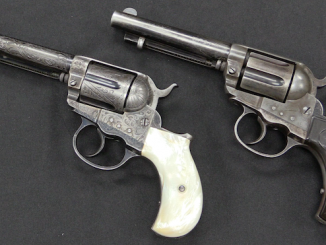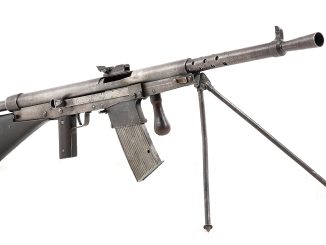William Dodge and his brother were inventors in Washington DC who in the 1870s patented a bunch of different improvements to the Remington Rolling Block, among other guns. This particular one I cannot identify with a specific patent, but to my eye it is a way to give the Rolling Block system a safe way to be carried with a loaded chamber. Using Dodge’s patent system here, the hammer can be lowered on a loaded chamber in a way that securely locks the hammer from falling and locks the breech from opening. This ensures that the action isn’t accidentally opened while carrying the gun. To fire, one need only cock the hammer back slightly and it is ready to use.
Despite there being no Dodge marking son this example, I am pretty confident that it is form the Dodge brothers because another example of the same system is in the Smithsonian collection attributed to Dodge – and Dodge sold his own gun collection to that museum in the early 20th century. It would stand to reason that they would have properly identified it.
That said, this system was never put into production. The US Army did experiment with a similar sort of half-cock safety on the Rolling Block carbines, but not of this design.
Update: It has been pointed out to me that the specific patent for this system is US Patent 113408A. It was specifically intended to keep the breechblock from opening in case of a cartridge discharging when the breech was closed (such as in case of the firing pin being jammed forward by something).




like the idea of “a light trigger pull” on a Rolling Block.
It looks like if the breech stirrup is engaged, the rifle could be fired accidentally by bumping the rolling block lever forward. Easier, cheaper and safer to just put a half cock notch on the rifle.
I have owned a Remington rolling block for about 40 years. It was a full length barrel and forearm, but I had it rebarelled for 45-70 with a shorter bull barrel and equipped it with a nice vernier rear sight and a hooded front sight with a spirit level. I shot it in many black powder silhouette matches and it is extremely accurate out to 500meters. It has a safety notch. I can see how the Dodge brothers modification would be useful in a military firearm. I’m surprised that Remington didn’t adopt it. Probably to expensive to machine or the Dodge brothers wanted to much royalty.
Were the Dodge brothers the same family that made the automobiles? Keep up the great work.
I made my comment before hearing about the half cock notch. A friend had one in .45-70, and always regretted selling it.
Maybe, but your comment made perfect sense. A half-cock notch would absolutely accomplish both objectives Ian cited in his opening. Some small hammers (like on cap’n’ball revolvers) are too fragile to rely on the notch, but there’s plenty of steel on the massive Rolling Block hammer.
Is lowering a cocked hammer to half-cock “asking for an accidental discharge”? Maybe to 2021 sensibilities, but it was familiar to EVERY shooter from the invention of the firearm lock to the late 19th Century, as the sole alternative to shooting the sky or ground each time he prepared for a shot that didn’t materialize.
Not that I have a problem with the Dodge safety, which looks reasonably effective, simple, and affordable, but the market apparently was quite satisfied with the half-cock notch.
“(…)market apparently was quite satisfied with the half-cock notch.”
Note that https://www.historynet.com/the-remington-rolling-block.htm
(…)Remington rolling-block cartridge rifle was so popular that more than half the world’s armies adopted it or purchased quantities for police or martial purposes.(…)
I bet due to how wars were destined to be fought in 19th century providing ability to safely carry rifle with cartridge in chamber for foot soldier was not deemed super important.
https://www.vislardica.com/19thc-articles-19th-century-wargaming-tactics
Infantry of the period still manoeuvred in massed columns or lines, wore gaudy uniforms in bright, morale-boosting colours, and attempted to close with the enemy rather than shoot them down from a safe distance. As late as the First World War, the French still believed that élan, or spirit, would carry their men forward through any hail of fire until positions could be taken at the point of the bayonet.
Line (infantry) was supposed to fire volley on command. If you intend to fight that way need for Rate-of-Fire is clear, but I fail to see how it would prompt developing ability to have cartridge ready to fire in chamber.
I’d agree with that view through the Napoleonic Wars, but Rolling Block-era powers did most of their fighting on the less-chessboardish fringes of their colonial empires.
“(…)Rolling Block-era powers did most of their fighting on the less-chessboardish fringes of their colonial empires.”
Military of France, which sported vast colonial empire in last quarter of 19th century, did not required their weapons, namely Lebel rifle and Berthier carbine to have ability to be safely carried with cartridge in chamber.
I’m not saying everyone prepared perfectly for every eventuality, just that a capability with little applicability on the formal battlefields you described would absolutely be advantageous in frontier wars.
Also, even if they ostensibly lack manual safeties, most properly designed manual repeaters can be safely carried just out of battery – a condition that is even safer, clearer, and generally requires much simpler motor skills to make ready under stress than the average manual safety.
“(…)Were the Dodge brothers the same family that made the automobiles?(…)”
I do cursory search looking for John Francis Dodge relatives
https://gw.geneanet.org/tdowling?n=dodge&oc=0&p=daniel+rugg&type=tree
but I failed to find any William Dodge alive in 1871 (year of mentioned U.S. patent)
What’s up with the finish on the piece? Looks like it had been lacquered or something?
Anyone seen that on arms of this era?
Looks like old Cosmoline.
It’s could be Cosmoline or oil. I owned that rifle for close to 20 years and never cleaned it off. I left it in the same condition as I got it. I also owned a model 1866 Springfield Trapdoor rifle at one time that had the same coating on it.
I think you are right, see my other post.
I found the book I thought I was looking for but it didn’t mention removal of varnish. It did mention the varnish like covering on the Rolling block Ian was showing us. They said it is most likely old cosmoline. They also said that it is very difficult to remove.
Book:
Restoring and preserving objects
Source:
J.M. Davis gun museum
Claremore, Oklahoma
I bought this pamphlet over 40 years ago for $1.00. If you love guns and are anywhere near Oklahoma, you should plan a day there. In the 80’s it was listed as the largest private collection of firearms in the world. I have spent many days there and I believe that they are right. Every time I would go there, I would formulate a list of guns that they didn’t have. Every time, I was wrong. It is truly an amazing place.
Per my father, USMC 1942-1946- the best way to remove cosmoline is gasoline, way out in the fresh air.
Breakcleaner or degreaser will do just the same. Or disassemble and cook it in water to get rid of every little trace of oil and grease. But why? The rifle looks as if it is in the white so better leave the grease on. Not pretty, but works fine to protect the bare steel from corrosion.
I make my pilgrimage to JM Davis a part of my trip to Tulsa twice a year.
I have a friend that lives in Ponca City and when hw was working I would drive to Claremore and have my nose pressed on the front door when they opened and would stay until they basically escorted me out at closing time. I haven’t been there in several years so when this Covid crap is over I intend to go again.
I have seen several old muzzleloaders with that dried up lacquer look on them. I own a 1828 muzzleloader 69 caliber musket that was converted to percussion in 1841 and someone varnished the stock but didn’t do the metalwork. Thank goodness… I have toyed with the idea of removing the varnish but there are several crisp cartouches and am afraid to mess them up. I had a book that mentioned how to remove varnish but now I can’t find it. As I recall they mentioned removing it with mineral spirits. I guess I will spend an hour or so trying to find that book. Getting old is a pain…
That cosmoline is part of the gun’s history. You wouldn’t refinish 17th. century furniture (unless somebody had painted it radiator silver at some point) if any of the old red or blue paint remained.
Patent 112694 should be the one you are looking for.
“Patent 112694 should be the one you are looking for.”(C)
Unlikely.
Rather one of
https://patentimages.storage.googleapis.com/b6/26/4c/663ee3c0e1c978/US112694-drawings-page-2.png
https://patentimages.storage.googleapis.com/a4/47/2a/66fc7c5e2a32ab/US113408-drawings-page-1.png
https://patentimages.storage.googleapis.com/aa/d6/1c/90dc114a1b3331/US127683-drawings-page-1.png
A solution in search of a problem? There were an awful lot of rolling blocks produced without this stuff.
Remember to visit the Blue Whale at Catoosha on your way back from JM Davis.
It looks like the Dodge brothers weren’t the only ones trying to improve the rolling block.
https://patentimages.storage.googleapis.com/59/8a/42/527569e00fe551/US50507-drawings-page-1.png
https://patentimages.storage.googleapis.com/82/51/ce/2848b639b24990/US126446-drawings-page-1.png
Rolling Block-era powers were often on the “fringes” themselves, and their soldiers were commonly unfamiliar with any mechanical device more complicated than a buckle. The simplicity of the rolling block was its best feature.
In the U.S. Ordnance manuals of the Civil War time frame, it mentions that “armory bright” rifles would be preserved with a coating made from linseed oil diluted with turpentine. The varnish we see is probably that.